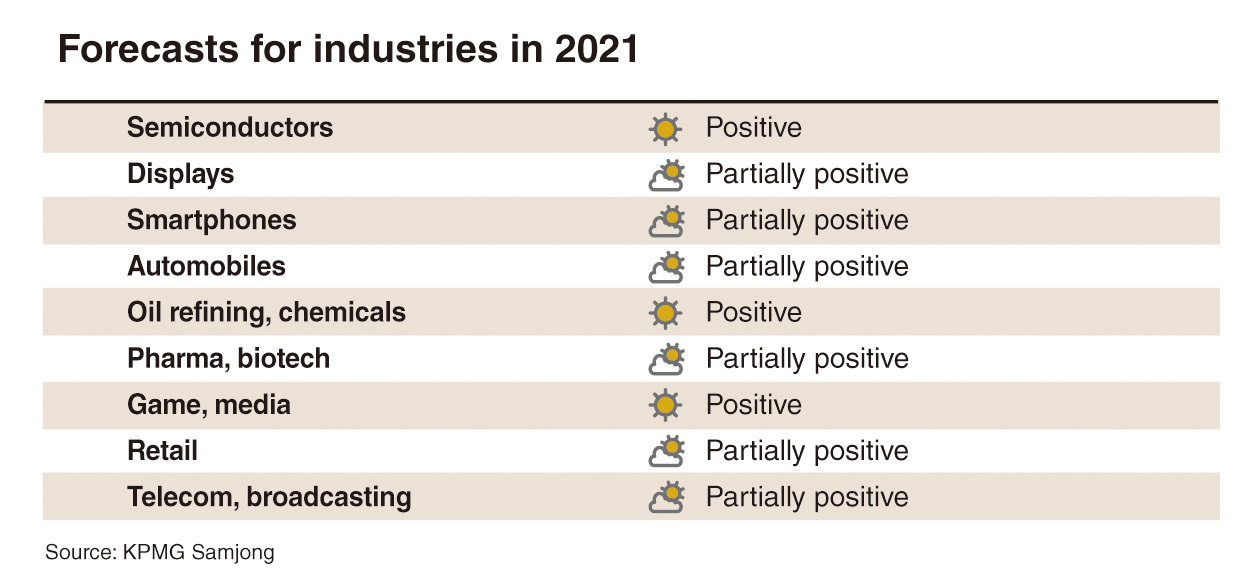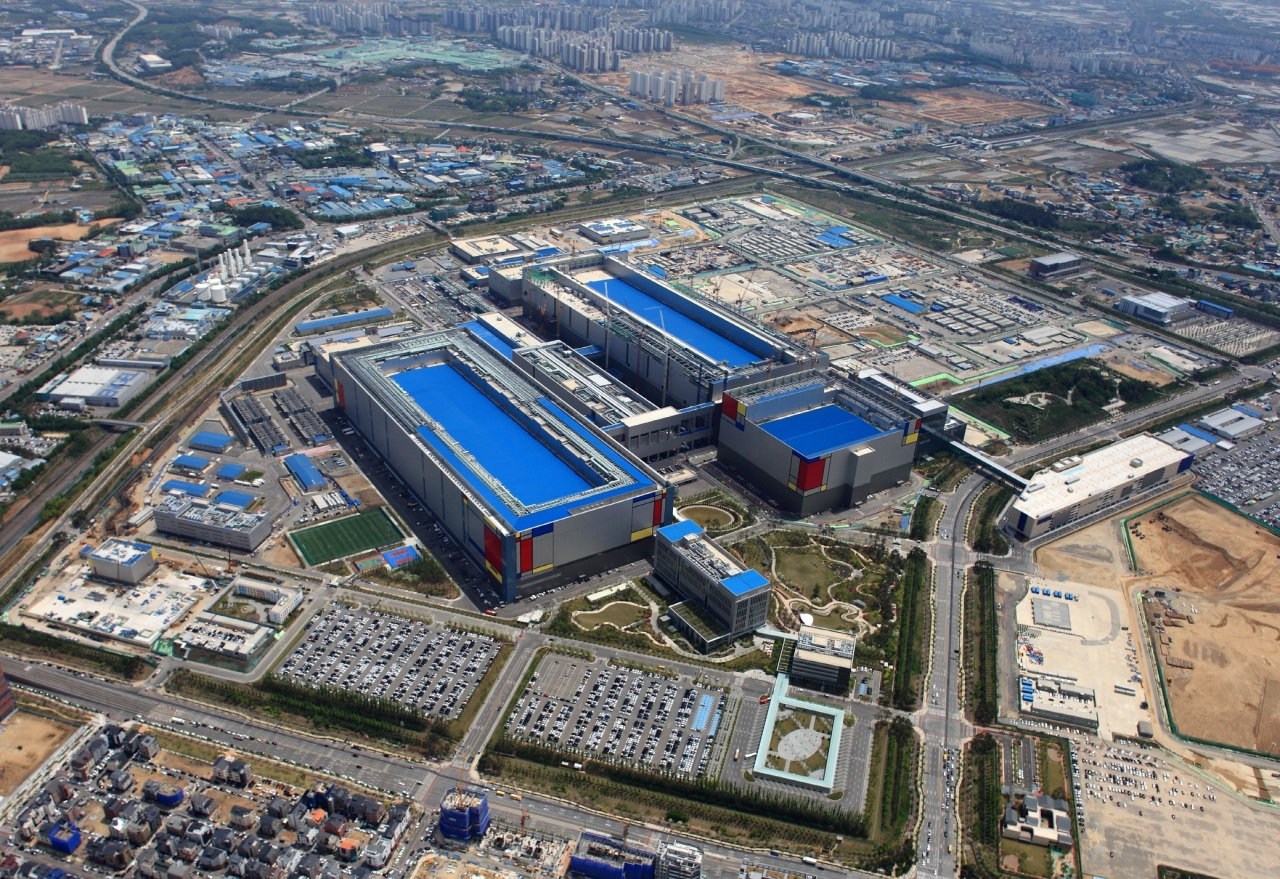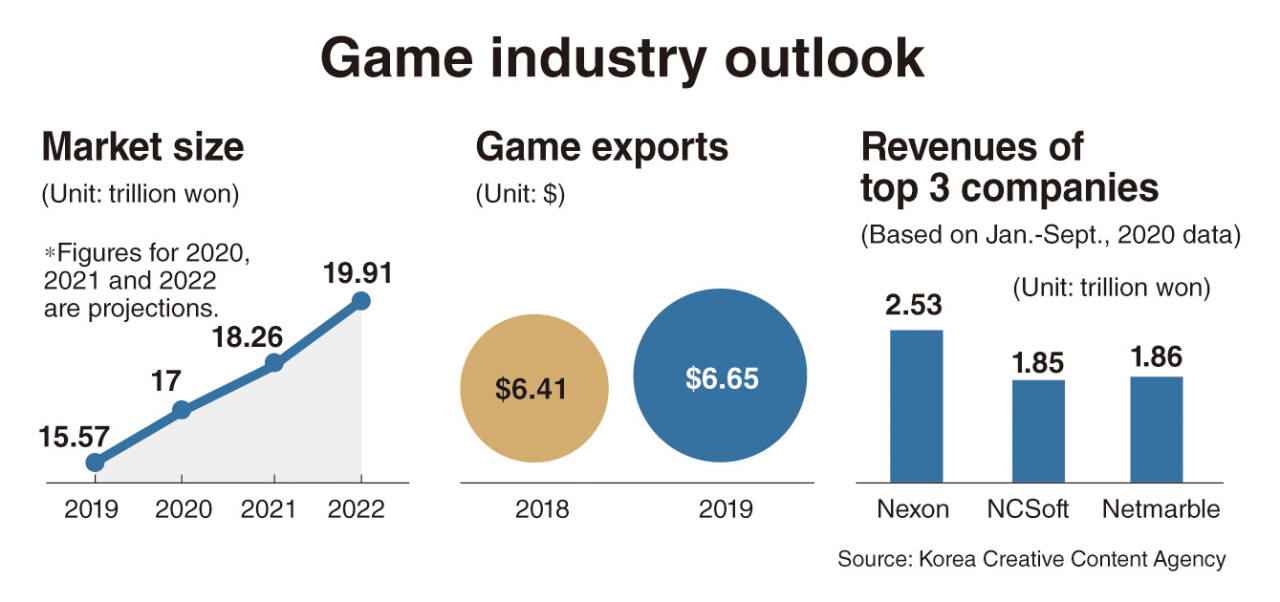[New Year Special] What will lead Korea’s economic recovery in 2021?
Growth after COVID-19 to come from IT, e-commerce, biotech and game industries
By Song Su-hyunPublished : Jan. 1, 2021 - 00:01

With 2020 behind us, the question now is what the recovery will look like for Korea Inc.
With COVID-19 still raging here and abroad, and the prospects for vaccination in South Korea appearing hazy, optimism and pessimism coexist.
But not much will change, economy-wise, for the next two quarters at least unless vaccines become easily accessible, according to a recent report from global consulting firm Deloitte.
Seoul-based consulting firm KPMG Samjong offers positive outlooks for sectors related to pharma, biotech, and information and communications technology, including semiconductors, smartphones and games, though it says many others will continue to experience adverse business conditions in 2021.
The Korea Herald has looked at a few of the industrial sectors that could very well lead the post-pandemic recovery this year.

Electronics leading overall recovery
The COVID-19 outbreak has made Korea’s electronics industry even stronger, and the sector is likely to remain a bellwether of the Korean economy in 2021.
As social distancing will be enforced at least until vaccines become widely available, tools that enable remote and non-face-to-face services – like mobile devices, tablet PCs and bigger screens with WiFi connectivity -- are expected to see robust demand, benefiting the electronics manufacturing sector.
After brief shutdowns of production facilities in Korea and other countries in the second quarter of last year, Korean electronics giants Samsung and LG managed to keep production running to meet the pent-up demand for home appliances and other devices from homebound consumers in the latter half of 2020.
“Under the pandemic situation, as education has moved online and people have become reliant on devices more than before at home to connect with outside world, some electronics products, that were not that popular before enjoyed the unsolicited gain,” said a marketing employee at Samsung Electronics.
Monitors were once deemed an outdated item amid the rapid growth of mobile devices and the demise of desktops, but they saw a “renaissance” last year upon unprecedented demand for telecommuting, videoconferencing and virtual gatherings.
According to a report by Deloitte, demand for large-screen TVs is also on the rise as consumers spend more time at home, and the trend is forecast to continue this year.
Sales of TVs larger than 65 inches surged 77 percent globally in the second quarter alone last year, the report noted.
Samsung is eyeing strong sales of even bigger TVs this year, having recently released its 110-inch Micro LED TV for home use. The company forecasts that the market for TVs bigger than 75 inches will expand from the current 5.5 million units to 7 million in 2021.
Due to the ever-growing public awareness of hygiene, another keyword in the home appliance sector is health.
LG seems poised to lead that trend this year. Sales of its hygiene-focused home appliances, such as its steam technology-based dishwasher, clothes care system, washing machine and dryer, surged significantly at home and abroad last year, according to the company.
Going further, LG is currently preparing to patent a new technology to disinfect the air, which would be incorporated into its air purifiers, according to industry sources.
During a recent webinar held by the Korea Industry Alliance Forum, the Korea Electronics Association forecast that electronics production would grow 3.9 percent to 481 trillion won ($443.81 billion) this year.
“Owing to the revenge spending sentiment under the pandemic, demand for premium products is expected to continue rising, leading to a larger share of the Korean manufacturers in the global market,” said KEA Director Ha Mong-yeol.
Prospects for the semiconductor industry, which accounts for about a fifth of Korea’s exports, remain bright for 2021.
According to KPMG Samjong, chipmaking is the most promising industry in terms of growth this year as noncontact businesses thrive.
“All kinds of semiconductor products would grow in sales, especially memory chips with an estimated sales growth of 13.3 percent,” the report said.
The Korea Semiconductor Industry Association forecasts that the country’s total chip exports will expand about 10 percent to $107.2 billion this year
“Due to the base effect of COVID-19 and delayed 5G network expansion, semiconductor demand is projected to surge,” said Ahn Ki-hyun, a senior official at the association.

IT giants expanding in e-commerce sector
Due to strict social distancing rules, many were forced to stay at home and e-connect to take care of routine everyday tasks, including education and shopping.
Local firms have not only been increasing investment to meet the needs of these shut-in consumers but also in preparation for the post-pandemic era.
Demand for online shopping is highly likely to continue to increase in Korea during the post-pandemic era, according to industry sources.
The presence of IT firms in the e-commerce sector, in particular the portal giant Naver and messenger mammoth Kakao, is expected to continue growing in light of their broad user base.
Korea’s online shopping market experienced a major boost last year, largely due to the COVID-19 pandemic.
In October, the volume of online shopping transactions here surpassed the 14 trillion won bar for the third consecutive month, according to Statistics Korea’s data.
According to the Korea Chain Store Association, the local e-commerce market is expected to reach all-time highs of 160.6 trillion won in 2020 and 188 trillion won this year.
Throughout last year, platform operators invested in improvements to their online shopping services to increase their presence in this rapidly growing market.
Among major players in the market, Naver is stepping up efforts to become the top player here.
According to a local market research firm, transactions made on the Naver portal during the first half last year reached 12.5 trillion won. The research firm added that the transaction volume for Naver’s own e-commerce platform, Naver Smart Store, came in third place, following e-commerce retailers Coupang and eBay Korea.
Last year, Naver increased investment in logistics firms to strengthen its distribution network, which was not as strong as those of its competitors.
Naver spent around 10 billion won this year on local startups that develop logistics solutions. Techtaka, a local startup that will roll out digitalized logistics solution Argo in January, was one of the startups that received investment from Naver.
Naver has also increased equity acquisitions in midsize and large logistics companies. Naver in November spent 40 billion won to acquire 10.3 percent of shares in Insungdata, the largest express delivery service provider with a 70 percent market share here. Earlier in October, Naver also cut a stock swap deal with CJ Logistics and acquired a 7.85 percent stake in the firm, worth 300 billion won.
CJ Logistics is one of several companies in Korea that provide overnight delivery service.
While improving the online shopping experience by strengthening its logistics system, Naver is also expected to invest in bringing more small and midsize firms onto its shopping platform, which will eventually lead to an increase in the transaction volume, according to an official from a local securities firm.
Naver CEO Han Sung-sook previously said the company would launch programs to link small and midsize enterprises with content creators and experts in a wide range of areas to facilitate smooth transitions to Naver Smart Store. The CEO added that the company would invest a total of 180 billion won to assist collaboration between local SMEs and content creators on the platform.

Potential heyday for bio and pharma
Many will remember 2020 as a business nightmare, but not the Korean biopharmaceutical industry.
The COVID-19 pandemic nudged the world to give Korea a second look for its ability to mobilize medical resources for fast diagnosis and quarantine. The country has never had to undergo a national shutdown but has kept a stable cap on the number of new infections, which has never exceeded 1,500 in a single day.
As of Dec. 30, Korea had some 60,000 confirmed coronavirus patients out of a population of roughly 52 million. This means only 0.11 percent of the population was infected with the coronavirus, in contrast with the worldwide average of 1 in 100.
In September, Korean pharmaceuticals exports posted a surplus for the first time since 1988, when the country began publicly announcing the monthly data. The aggregate export volume during the first nine months of the year surpassed $10 billion for the first time in history, according to the state-run Korea Customs Service.
Exports of COVID-19 test kits grew incrementally from $0.6 million in February to $328 million in September, customs representatives said.
In 2021, the pharmaceutical and biologics industry is expected to continue on this path to what could become its heyday.
From 2021 to 2023, the state and the industry plan to join forces to propel the growth of pharmaceuticals, medical devices, digital health care and related infrastructure, according to a plan reported to President Moon Jae-in by the ministries of Commerce, Science and Health at an event at the Yonsei University International Campus in Songdo, Incheon.
The Moon administration has vowed to support players in the biohealth industry by investing some 10 trillion won by 2023. The government will focus its support measures on expediting the development of new technologies into marketable assets, as well as on encouraging cross-industrial research and development for new economic motors.
These endeavors should lead to 9,300 more jobs and an annual average manufacturing growth rate of 20 percent by 2023, Moon forecast.
Bio will be incorporated into the core industrial areas of electronics, chemical materials, energy and manufacturing, Moon said, which will lead to innovations such as human-augmented robots, brain-computer interfaces, biodegradable plastic, functional fabric, green energy and microbiome-powered manufacturing models.
Similarly, biotechnologies paired with information technologies could propel advances in data, networks, artificial intelligence and electronics and yield big data-based personalized medicine, real-time monitoring of patients, AI-enabled development of medical devices and novel drugs, and the semiconductor-powered early diagnosis of illnesses.

Games, the new game changer
The Korean game industry, which accounted for 16 percent of the country’s trade surplus of $6.4 billion in 2018, is expected to gain extra momentum and a bigger role this year in the coronavirus-hit economy.
According to the Korea Creative Content Agency’s 2020 White Paper on Korean Games, released Dec. 20, the Korean game industry last year was projected to grow 9.2 percent on-year to 17 trillion won, as games have emerged as a major form of non-face-to-face content amid the pandemic.
“As people are spending more time at home and increasing their non-face-to-face activities, they are playing more mobile games. Thanks to their accessibility, smartphones are likely to become one of the most important game platforms,” a KCCA official said.
Last year the mobile game market was expected to see a 21.4 percent spike in sales to 9.3 trillion won, accounting for 55.2 percent of Korean game industry sales. This would be the first time mobile games commanded more than 50 percent of the industry.
“Games are likely to take a leap to a ‘leading industry’ in the post-coronavirus era. The whole content industry, where emphasis has been put on movies and music, is likely to be reorganized by the game industry, for multiple reasons,” said Moon Dong-yeol, CEO of Redbros, a local media content company.
According to the CEO, people are playing games not because they can’t get outside, but because they are an extremely inexpensive form of content to enjoy in recession, as most mobile games on the market are free to play.
Also, the gaming population is continuing to grow, as even people in their 40s and 50s grew up playing games, the CEO added. The population of mobile game players in Korea, estimated at 20.5 million people last year, is expected to grow to 21 million next year, according to Statista.
Buoyed by favorable market conditions, the Korean game industry is expected to expand from last year’s 17 trillion won to 18.2 trillion won this year and 19.9 trillion won next year.
As of last year, Nexon, Netmarble and NCSoft, which are the three major Korean game developers and are also called “3N,” are expected to breach the 7 trillion won mark in annual sales for the first time.
After going public in September, Kakao Games, the gaming unit of Korea’s leading messenger app operator, Kakao, witnessed record quarterly revenue of 150.5 billion won, a 54.2 percent jump on-year.
To further support the booming game industry, the ruling Democratic Party in November proposed the comprehensive revision of current game laws to reflect trends in the fast-changing game industry.
The revision will establish an agency dedicated to the game industry and create a game cluster and related supporting facilities. Also, the agency will support the development, production, retail marketing and export of Korean games.
By the IT team
(song@heraldcorp.com)
(kaylalim@heraldcorp.com)
(ws@heraldcorp.com)
(kbw@heraldcorp.com)



















![[Today’s K-pop] BTS pop-up event to come to Seoul](http://res.heraldm.com/phpwas/restmb_idxmake.php?idx=642&simg=/content/image/2024/04/17/20240417050734_0.jpg&u=)